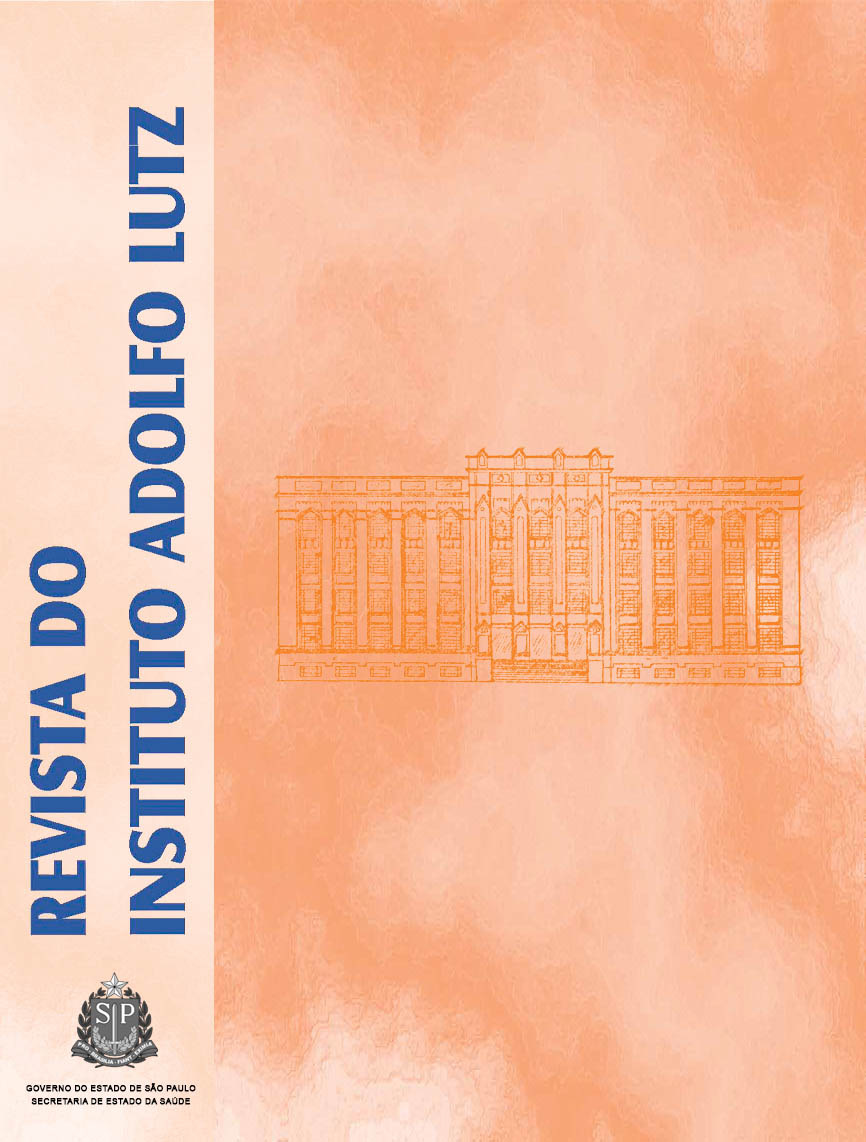Abstract
Gram-negative aerobic bacteria are found in nearly 7% of soil resident-bacteria population. Many bacteria species are pathogenic, and they are responsible for nosocomial infections. Antimicrobial drugs resistance is relevant for assessing the potential pathogenic features of circulating bacteria strains. The aim of the present study was to identify Gram-negative bacilli (GNB) isolated from soil,and to test the antimicrobial resistance. Eighteen soil samples were inoculated into Hajna's broth for enrichment. Bacterial isolation was done on Mc Conkey agar and Müeller Hinton blood agar. Isolated bacteria colonies (283) were inoculated onto modified Rugai medium for screening the fermentative GNB and non-fermentative GNB, and followed by identification by means of conventional methodology. Most of them (94. 35%) belonged to Enterobacteriaceae,and 5. 65% were non-fermentative GNB. High rates of bacterial resistance were evidenced to ampicillin, cefalotin, cefoxitin, amoxicillin+clavulanic acid, and tetracycline,varying from 49. 82% to 87. 28%. All of the isolated bacteria showed resistance to at least one antibiotic. These results provide remarkable data on pathogenic potential as a constituent of a resistance reservoir. Further studies on the relationship between soil and antimicrobial resistance needs to be performed. Then the advanced experiments and observations will provide best understanding on the mechanism and the process associated with the emergence of environmental drug-resistant bacteria.References
1. Sagardoy MA, Salerno C M. Number, distribution, and characterizationof heterotrophic bacteria in some Argentine soils. An Edafol Agrobiol1983; 42: 269-81.
2. Cuppels D, Kelman A. Evaluation of seletive media for isolation ofsoft-rot bacteria from soil and plant tissue. Phytopathology 1973;64:468-75.
3. Gilligan PH, Whittier S. Burkholderia, Stenotrophomonas, Ralstonia,Brevudimonas, Comamonas, and Acidovorax. In: Murray PR et al.Manual of Clinical Microbiology. 7a ed. Washington: ASM Press,1999. p. 526-38.
4. Holt JG et al. Gram-negative aerobic/microaerophilic rods and cocci.In: Krieg NR, Holt JG, Berget DH, Sneath PHA. Bergey’s Manual ofDeterminative Bacteriology. 9a ed. Baltimore: Williams & Wilkins,1994. p. 71-174.
5. Kiska DL, Gilligan PH Pseudomonas. In: Murray PR et al. Manual ofClinical Microbiology. 7a ed. Washington: ASM Press, 1999. p. 517-25.
6. Schcreckenberger PC, von Graevenitz A. Acinetobacter,Achromobacter, Alcaligenes, Moraxella, Methylobacterium, and OtherNonfermentative Gram-Negative Rods. In: Murray PR et al. Manualof Clinical Microbiology. 7a ed. Washington: ASM Press, 1999. p.539-60.
7. Farmer III J J. Enterobacteriaceae: Introduction and identification.In: Murray PR et al. Manual of Clinical Microbiology. 7a ed.Washington: ASM Press, 1999. p. 442-58.
8. Koneman EW et al. Enterobacteriaceae. In Koneman EW, Allen SD,Janda WM, Schereckenber PC. Diagnóstico Microbiológico: Texto eAtlas Colorido. 2a ed. S. Paulo: Panamericana, 1993. p.61 - 132.
9. Holding AJ. The proporties and classification of the predominantGram-negative bacteria occurring in soil. J Appl Bacteriol 1960; 23(3):515-25.
10. Abbott S. Klebsiella, Enterobacter, Citrobacter, and Serratia. In: MurrayPR et al. Manual of Clinical Microbiology. 7a ed. Washington: ASMPress; 1999. p. 475-82.
11. Goñi-Urriza M et al. Impact of an Urban Effluent on AntibioticResistance of Riverine Enterobacteriaceae and Aeromonas spp. ApplEnviron Microbiol 2000; 66 (1):125-32.
12. Difco: DifcoManual - Medios de cultivo deshidratados y reactivos paramicrobiologia. 10a ed. Madrid: Graficas letra, S. A., 1984. 1166 pp.
13. Pessoa GVA, Silva EAM. Meios de Rugai e Lisina-Motilidadecombinados em um só tubo para identificação presuntiva deenterobactérias. Rev Inst Adolfo Lutz 1972; 32: 97-100.
14. Koneman EW et al. Bacilos Gram negativos não fermentadores. In:Koneman EW, Allen SD, Janda WM, Schereckenber PC. DiagnósticoMicrobiológico: Texto e Atlas Colorido. 2a ed. S. Paulo: Panamericana,1993. p. 133 - 97.
15. Sneath PHA. Bacterial classification. II. Numerical taxonomy. In:Krieg NR et al.Bergey’s Manual of Systematic Bacteriology. vol. 1.Baltimore: Williams & Wilkins, 1984. p. 5-7.
16. National Committee for Clinical Laboratory Standards. Performancestandards for antimicrobial disk susceptibility tests. Approved standardM2-A6. NCCLS, Wayne, Pa. 1997.
17. National Committee for Clinical Laboratory Standards. Performancestandards for antimicrobial disk susceptibility testing; FourteenthInformational Supplement. Approved standard M 100-S14. NCCLS,Wayne, Pa. 2004.
18. Jorgensen JH et al. Antibacterial susceptibility tests: dilution and diskdiffusion methods. In: Murray PR et al. Manual of ClinicalMicrobiology. 7a ed. Washington: ASM Press, 1999. p. 1526-43.
19. Khachatourians GG et al. Agricultural use of antibiotics and the evolutionand transfer of antibiotic-resistant bacteria. Can Med Assoc J 1998;59: 1129-36.
20. Meng J et al. Antibiotic resistance of Escherichia coli O157:H7 andO157:NM isolated from animals, food, and humans. J Food Prot1998; 61: 1511-4.
21. Guardabassi L et al. Antibiotic resistance in Acinetobacter spp. isolatedfrom sewers receiving waste effluent from a hospital and apharmaceutical plant. Appl Environ Microbiol 1998; 64:3499-502.
22. Österblad M et al. Antimicrobial susceptibility of Enterobacteriaceaeisolated from vegetables. J Antimicrob Chemother 1999; 43: 503-9.
23. Timko J, Kmeê V. Susceptibility of Enterobacteriaceae from theAlpine Accentor Prunella collaris. Acta Vet. Brno 2003; 72: 285-8.
24. Calva JJ, Sufuentes–Osonio J, Ceren C. Antimicrobial resistance infecal flora: longitudinal community-based surveillance of children fromurban México. Anticrob Agents Chemother 1996; 40:1699-702.
25. Wenzel RP et al. In Vitro Susceptibilities of Gram-Negative BacteriaIsolated from Hospitalized Patients in Four European Countries,Canada, and the United States in 2000-2001 to Expanded-SpectrumCephalosporins and Comparator Antimicrobials: Implications forTherapy. Antimicrob Agents Chemother 2003;47: 3089-98.
26. Schmidt AS et al. Occurrence of antimicrobial resistance in fish-pathogenic and environmental bacteria associated with four Danishrainbow trout farms. Appl Environ Microbiol 2000; 66: 4908-15.
27. Arvanitidou M, Katsouyannopoulos V, Tsakris A. Antibiotic resistancepatterns of enterococci isolated from coastal bathing waters. J MedMicrobiol 2001; 50:1001-5.
28. Lobova TI et al. Geographical and seasonal distribution of multipleantibiotic resistance of heterotrophic bacteria of Lake Shira. AquaticEcology 2002; 36: 299-307.
29. Martínez JL et al. Resistance to betalactam/clavulanate. Lancet 1987;2: 147-53.
30. Page JWJ, Farmer TH, Elson SW. Hyperproduction of TEM-1 b-lactamase by Escherichia coli strains. J Antimicrob Chemother 1989;23: 160-1.
31. Visalli MA, Jacobs MR, Appelbaum PC. Susceptibilities of non-Pseudomonas aeruginosa Gram-negative nonfermentative rods tociprofloxacin, ofloxacin, levofloxacin, D-ofloxacin, sparfloxacin, ceftazidime, piperacillin, piperacillin-tazobactam, trimethoprim-sulfamethoxazole, and imipenem. Antimicrob Agents Chemother 1996;40: 772-5.

This work is licensed under a Creative Commons Attribution 4.0 International License.
Copyright (c) 2005 Instituto Adolfo Lutz Journal
